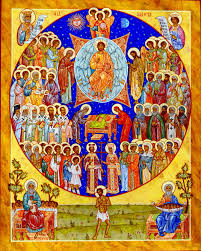A Roman Catholic Parish
The Personal Ordinariate of S. Peter
Eutaw Street and Madison Avenue
Baltimore, Maryland
ALL SAINTS
November 1, 2019
7:00 P.M. Sung Mass
Rev. Albert Scharbach, Pastor
Dr. Allen Buskirk, Choirmaster
Midori Ataka, Organist
___________________
Not a great deal is known about the life of John Taverner. He is thought to have been born around 1490 in Lincolnshire, and is first documented in 1525 as a lay clerk at the collegiate church of Tattershall, a musical establishment of some importance. Later that year he was recommended by Bishop Longland of Lincoln for the new post of Informator (choirmaster) at Cardinal College (now Christ Church), Oxford, founded by Cardinal Wolsey and lavishly endowed with a choir of sixteen choristers and twelve ‘clerkes skilled in polyphony’. After overcoming an initial reluctance to leave the security of Tattershall, he accepted this prestigious invitation in time for the formal opening of the College in October 1526. Its glory proved to be short-lived, however, and after Wolsey’s fall from power in 1529 its fortunes and finances soon began to decline. Taverner resigned the post in 1530. For the next seven years his whereabouts are unknown. Possibly he worked as a freelance musician in London, or perhaps he returned directly to Lincolnshire. From 1537 Taverner was in Boston, maybe employed as an agent for Thomas Cromwell, who had been commissioned by Henry VIII to carry out a survey and valuation of the lesser monasteries and friaries prior to their dissolution. There is no truth in the persistent claim that Taverner was a fanatical persecutor in carrying out these duties. The significance of the often-quoted note in the 1583 edition of Foxe’s Acts and Monuments that Taverner came ‘to repent him very much that he had made songs to popish ditties in the time of his blindness’ may well have been exaggerated; Foxe, an ardent Protestant, was writing some forty years after the composer’s death, and the term ‘popish ditties’ remains open to interpretation. On the contrary, there is documentary evidence that Taverner had genuine concern for the welfare of the monks and friars. The assumption that he ceased to compose after leaving Oxford is based on speculation, since a proportion of his output has probably been lost and what has survived is not always easy to date.Taverner died in 1545 and was buried beneath the famous ‘stump’ of Boston church.
The Mass is scored for five voices, within which Taverner makes effective use of contrasting high and low groups. Simple and clear textures, and extensive use of imitation, combine to create a decidedly more ‘modern’ music than is found in his large-scale and elaborate six-voice masses. The Sanctus-Benedictus and Agnus Dei are given melismatic treatment. Taverner achieves a marvellous sense of climax through his favourite device of melodic sequence in the Osanna of the Sanctus.
___________________
O quam gloriosum, William Byrd (1540-1623)
The first two verses of the hymn are a description of the saints arrayed before God’s throne, asking the question: who are they? Verse three begins to answer the question. So verse four is an answer to the question of who are the saints? What is wonderful about verse four is that it describes people who do not simply submit to God’s will: “who in prayer full oft have striven with the God they glorified.” In other words, their prayer has often been an intense struggle with God. It’s a powerful description of one aspect of a devout Christian life. Like Jacob, we often wrestle with God about His seeming absence in our anguish; Jesus too cried “my God, my God, why hast Thou forsaken me?”
Here is the Wakefield Cathedral Choir.
#585 Jerusalem, my happy home has a complicated history. It may have been written by a 16th century Catholic priest “F. B. P” (¿Francis Baker Porter?) imprisoned in the Tower and it may be based on The Meditations of St. Augustine. It exists in several versions; the one we use was said to be the favorite hymn of Elizabeth Ann Seton.As adults, we know we live in a vale of tears: the disappointments of life, the sickness and death of friends and family, the destruction that evil works in God’s creation. This world as it now exists is not our home, which we will find in the transfigured world of the New Creation. The disharmony of the present age will be replaced by the harmony of heaven, symbolized by music, the new song, canticum novum, that we will forever sing.
LAND OF REST is an American folk tune with roots in the ballads of northern England and Scotland. It was known throughout the Appalachians; a shape-note version of the tune was published in The Sacred Harp (1844).
#126 For all the saints is by the Anglican bishop William Walsham How (1823—1897), who was a great friend of the poor of his diocese, and was known variously as ‘the children’s bishop’, ‘the poor man’s bishop’ and ‘the omnibus bishop’ (the last referring to his preferred means of travel about his diocese).
This hymn derives much of its power from its ability to capture the spirit of the Church Militant here on earth, using imagery from the book of Revelation. Vaughan Williams composed the tune SINE NOMINE (‘without a name’) for this hymn. It has been suggested that the name of the tune refers to the countless number of saints who are not remembered by name but who are part of the ‘glorious company’.
Here is the St. Edmundsbury Cathedral Choir.
